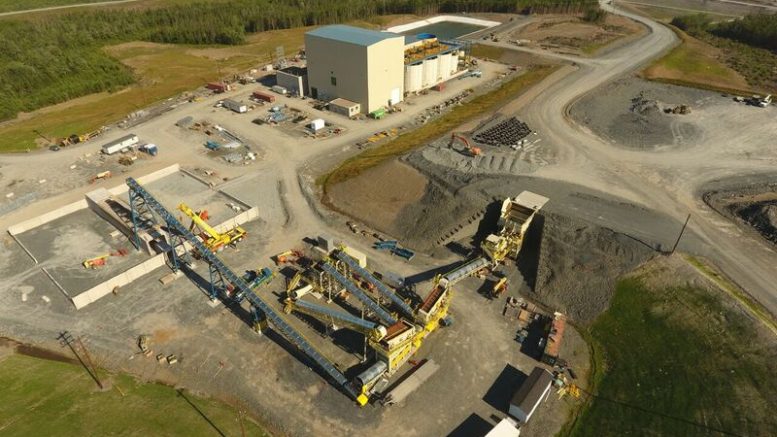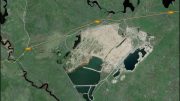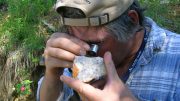VANCOUVER — Atlantic Gold (TSXV: AGB) is on the fast track to first production at its Moose River Consolidated gold project in Nova Scotia. Its district-scale vision, however, extends beyond the mine life outlined in a mid-2015 feasibility study.
The company is putting the finishing touches on a US$156-million, open-pit mine built 85 km northeast of Halifax that should first gold poured by early next year.
The mine could produce 87,000 oz. gold annually over an 8.5-year mine life, at all-in sustaining costs of US$531 per oz. gold.

The western open pit at Atlantic Gold’s Touquoy gold project. Credit: Atlantic Gold.
The 5,500-tonne-per-day mill would have a 94% gold recovery rate using a conventional flow sheet consisting of three-stage crushing and ball milling, with cyclones used to close the grinding circuit.
Tailings from leaching would be treated for cyanide destruction using sulphur dioxide and air with a copper catalyst.
Proven and probable reserves total 16.5 million tonnes at 1.44 grams gold per tonne for 760,000 contained oz. gold, using a 0.4 gram gold lower cut-off grade.
The company’s first mill feed will come from the central Touquoy deposit and the satellite Beaver Dam project, 37 km to the northeast.
“We’ve been focused on the tailings facility design, and I’m happy to report everything is on track,” Atlantic chief operating officer Maryse Belanger says during an interview. “We’re coming up quickly on commissioning and I don’t foresee any issues.

Carbon-in-leach (CIL) structural progress at the Touquoy gold project. Credit: Atlantic Gold.
“Our goal, however, is to continue with exploration to expand our production profile. We’ve developed an understanding of regional geology and structural aspects of the mineralization that can lead to more discoveries.”
Atlantic plans to incorporate its nearby Cochrane Hill and Fifteen Mile Stream gold deposits into a prefeasibility study by the fourth quarter. The company released an updated resource estimate on the satellite deposits in July.
Fifteen Mile lies 57 km northeast of the mill and hosts 9.8 million measured and indicated tonnes at 1.4 grams gold for 442,000 contained oz. gold.
Meanwhile, Cochrane Hill sits 80 km northeast of Touquoy and hosts 10 million measured and indicated tonnes at 1.21 grams gold for 390,000 contained oz. gold.
“Fifteen Mile looks attractive due to its combination of strip ratio, transportation synergies and grade profile. It’s also encouraging that we’ve dropped the strip ratio at Cochrane Hill and increased the prospective recovery rates,” Belanger says.
She adds that Atlantic Gold is exploring pre-concentration at the satellite deposits to decrease the environmental footprint and increase efficiency. That would involve crushing, grinding, gravity and flotation to produce concentrate that can be trucked to the cyanidation circuit.
“We’re looking at the potential mine sequence now that we have the updated resources,” she says.

The Caterpillar mine fleet at the Touquoy site. Credit: Atlantic Gold.
Atlantic’s plan has its Touquoy mining fleet transitioning to Beaver Dam after five years. The fleet would also be expanded due to a higher rate of material movement.
Furthermore, the company intends to crush ore on location near Highway 224 and load it onto trucks for transport via private logging and public roads to the Touquoy facility.
Beaver Dam waste rock would be placed “as close to the pit as practical to minimize waste-haulage costs.
“Transportation will be a major consideration for us alongside strip ratio and grade. We’ll use existing forestry roads, for example, so in the near future we’ll complete a study that considers items like bridges and related infrastructure,” Belanger says.
“Our central crushing and grinding circuit has been designed with the harder Beaver Dam ore in mind. [Fifteen Mile] looks quite similar to Touquoy in terms of metallurgy, but Cochrane has a bit more quartz veining and graywacke. So we’ll look at all those recovery-related and logistic elements,” she adds.
Longer term, Atlantic wants to leverage its growing geological database to identify other prospects across its 210 sq. km land package in southwestern Nova Scotia.
The company’s working theory is that historic miners and explorers didn’t realize that gold mineralization extends into sedimentary rocks that surround gold-bearing quartz veins across the regional Meguma geological terrane.
Atlantic’s exploration has largely been driven by historic records and scout, reverse-circulation (RC) drilling aimed at identifying prospective stratigraphies.
The company reported high-grade drill results, in both the argillites and quartz veins, at its Plenty prospect 300 metres south of Fifteen Mile in January. Highlights include: 13 metres of 21.8 grams gold from 32 metres deep in hole 16-3; and 16 metres of 5.63 grams gold from 43 metres deep in hole 16-4.
“We can take our experience and apply it regionally,” Belanger says. “We’re fortunate to have historic data, since geochemistry isn’t useful due to overburden. We’re leveraging RC drilling to identify areas of interest. We’re working through results from our most recent drill program, and we’ll get back to regional exploration later this year.”

Maryse Belanger, COO, Atlantic Gold.
BMO Capital Markets analyst Andrew Mikitchook models that adding the Cochrane Hill and Fifteen Mile resources to Atlantic’s mine plan could see its production profile grow to least 150,000 oz. per year by 2022. He boosted his price target on Atlantic Gold shares by 20¢ to $2.20 after the update.
Atlantic Gold shares have traded in a 52-week range of 76¢ to $1.64, and closed at $1.37 per share at press time.
The company reported cash and equivalents of $11.3 million at the end of March.
It has 177 million shares outstanding for a $242-million market capitalization.
Atlantic Gold’s leadership includes notable veterans such as chairman and CEO Steven Dean (former president of Teck Cominco); vice-chairman Robert G. Atkinson (former president and CEO of brokerage house Loewen Ondaatje McCutcheon & Co.); and director of exploration Wally Bucknell (former GM of exploration for Plutonic Resources). Currently no one serves as Atlantic Gold president.






Be the first to comment on "Atlantic Gold builds critical mass"